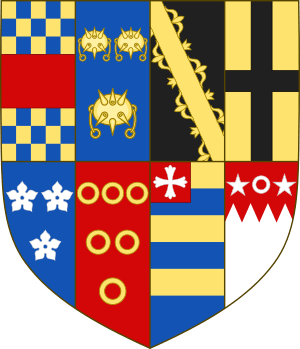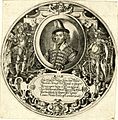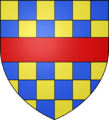George Clifford, 3rd Earl of Cumberland facts for kids
Quick facts for kids
George Clifford
|
|
|---|---|
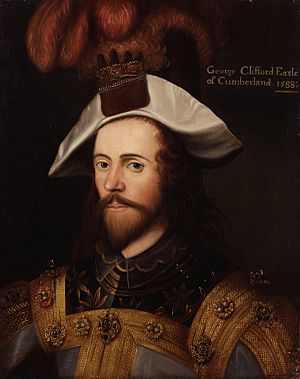
George Clifford, 3rd Earl of Cumberland, after Nicholas Hilliard
|
|
| Born | 8 August 1558 Brougham Castle, Westmorland, England. |
| Died | 30 October 1605 (aged 47) Liberty of the Savoy, London, England. |
| Title | Earl of Cumberland |
| Tenure | January 1570 – 30 October 1605 |
| Other titles | 13th Baron de Clifford 13th Lord of Skipton |
| Nationality | English |
| Residence | Appleby Castle Brougham Castle Skipton Castle Londesborough Hall |
| Spouse(s) | Lady Margaret Russell |
| Issue | Anne Clifford, 14th Baroness de Clifford suo jure |
| Parents | Henry Clifford, 2nd Earl of Cumberland Anne Dacre |
|
|
|
Sir George Clifford, 3rd Earl of Cumberland (born August 8, 1558 – died October 30, 1605), was an important English nobleman and naval leader. He served Queen Elizabeth I of England as a courtier, which means he was an attendant at her royal court.
George Clifford was especially known for his skill in jousting tournaments. These events were a big part of court life. His famous portrait miniature by Nicholas Hilliard and his special Greenwich armour show how important jousting was to him.
Contents
Early Life and Becoming an Earl
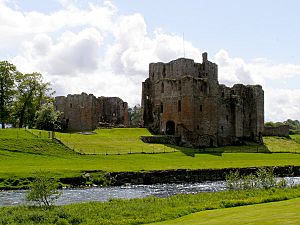
George Clifford was born on August 8, 1558, at Brougham Castle in Westmorland, England. His father was Henry Clifford, 2nd Earl of Cumberland. His mother was Anne Dacre.
The Clifford family had lived at Appleby Castle in northern England since the late 1200s. When George's father passed away in 1570, George became the Earl of Cumberland and Baron de Clifford. He was only 12 years old at the time.
Because he was so young, Queen Elizabeth I placed him under the care of Francis Russell, 2nd Earl of Bedford. In 1577, George married Russell's daughter, Lady Margaret Russell. Their marriage had been planned when they were very young.
Life at the Royal Court
Spending time at the Queen's court meant George lived mostly in southern England. This meant he was often far from his family's homes in the north. Because of this, some of his properties, like Brougham Castle, were not well looked after. However, in 1589, he built a new country house called Londesborough Hall.
People at court described George Clifford as a very handsome man. He was strong, active, and good at knightly sports. He also dressed very grandly and was known for his bravery.
Queen's Champion and Knight of the Garter
George Clifford became a very skilled jouster. He was chosen as Queen Elizabeth's second Queen's Champion. This was a very special role. A portrait miniature painted around 1590 shows him in his jousting clothes. He has the Queen's glove, decorated with diamonds, pinned to his hat. This showed he had the Queen's favor.
In 1592, the Queen made him a Knight of the Garter. This is a very high honor in England. He also took part in important legal proceedings as a Peer. Clifford also helped to start the East India Company, which was a major trading company.
Clifford was a man who loved adventure. He spent a lot of his money, so he looked for ways to earn more. He found an opportunity in the war against Spain.
In 1588, he commanded a ship called the Elizabeth Bonaventure during the Anglo-Spanish War. He had some success in this war. His picture was even included in the famous Armada Tapestries.
He led and invested in many sea expeditions. Some of these trips faced bad storms or did not find much treasure. His first big success was an expedition to the Azores in 1589. There, he captured several Portuguese and Spanish ships.
In 1592, he helped Walter Raleigh prepare an expedition. This led to the Battle of Flores. They captured a very rich Portuguese ship called the Madre de Deus. Later, in 1593, Clifford funded three more ships for an expedition to the Azores.
Clifford even had his own ship built. It was called the Scourge of Malice and had 38 guns. In 1598, during the Battle of San Juan, he became famous for briefly capturing Fort San Felipe del Morro. This fort protected San Juan, Puerto Rico. Clifford and his men arrived in Puerto Rico in June 1598. However, they had to leave by November because many of his men became very sick.
George Clifford was known for his great courage. He was willing to risk his money and his safety for adventure. He gained a lot of wealth from his sea voyages. However, he also spent a lot of money on jousting and horse racing. Eventually, he had to sell some of the lands he had inherited.
Family and Inheritance
In 1577, George married Lady Margaret Russell. She was the daughter of his guardian, Francis Russell. George and Margaret had three children:
- Robert Clifford (born 1585 – died 1591), who passed away young.
- Francis Clifford (born 1584 – died 1589), who also passed away young.
- Lady Anne Clifford (born 1590 – died 1676). She was their only child who lived to adulthood.
Since both of his sons died young, his daughter Anne became his only heir. She inherited the title Baron de Clifford because this title could be passed down to a female. She also inherited a large sum of money.
However, George Clifford left most of his other property to his brother, Francis Clifford, 4th Earl of Cumberland. His brother also inherited the title of Earl, which could not be passed to a female. After a long legal fight, Anne Clifford won back much of the land, including Brougham Castle and Appleby Castle.
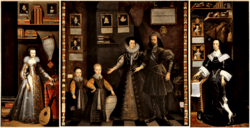
The Great Picture is a very large painting that Anne Clifford ordered in 1646. It shows her as a young girl on one side and as an adult on the other. The middle part shows her parents and her two young brothers. The painting includes many details about her life and her long fight to inherit her family's lands. This legal dispute was finally settled in 1617.
Death and Burial
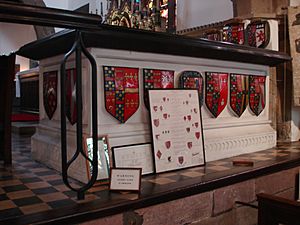
George Clifford passed away on October 30, 1605, in London. His body was taken to the family burial place at Skipton Castle in Yorkshire. His daughter, Lady Anne Clifford, had a black marble tomb built there to remember him.
His tomb monument can also be seen in Holy Trinity church in Skipton. It is decorated with many family crests and symbols.
Sir George Clifford's Tournament Armour
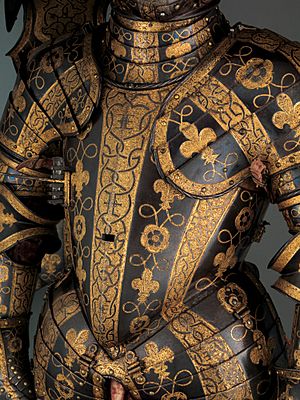
George Clifford's special tournament armour still exists today. It is considered one of the most beautiful sets of armour from the Tudor period. Since he was the Queen's Champion, his armour was truly special.
This armour was made at the Greenwich armoury, which was started by King Henry VIII. A drawing of his armour is in the Jacob Album, a book that shows designs for different armours. Clifford's armour is a "garniture," which means it came with many extra pieces. These extra parts allowed him to change his armour for different types of jousting and combat.
The armour is made of dark blue steel. It has fancy gold designs etched into it. These designs include fleurs-de-lis (a French lily symbol) and Tudor roses (an English rose symbol). It also has the letter "E" for Queen Elizabeth I. You can see this amazing armour at the Metropolitan Museum of Art in New York.
George Clifford in Literature
George Clifford is mentioned in the novel Orlando: A Biography by Virginia Woolf. In the story, a character called the "Earl of Cumberland" finds Orlando and his friend asleep. He thinks they are ghosts and promises to change his ways. He then builds some almshouses (charitable homes). Even though the book doesn't say which Earl it is, it's understood to be the 3rd Earl because of when the story takes place.
Images for kids


